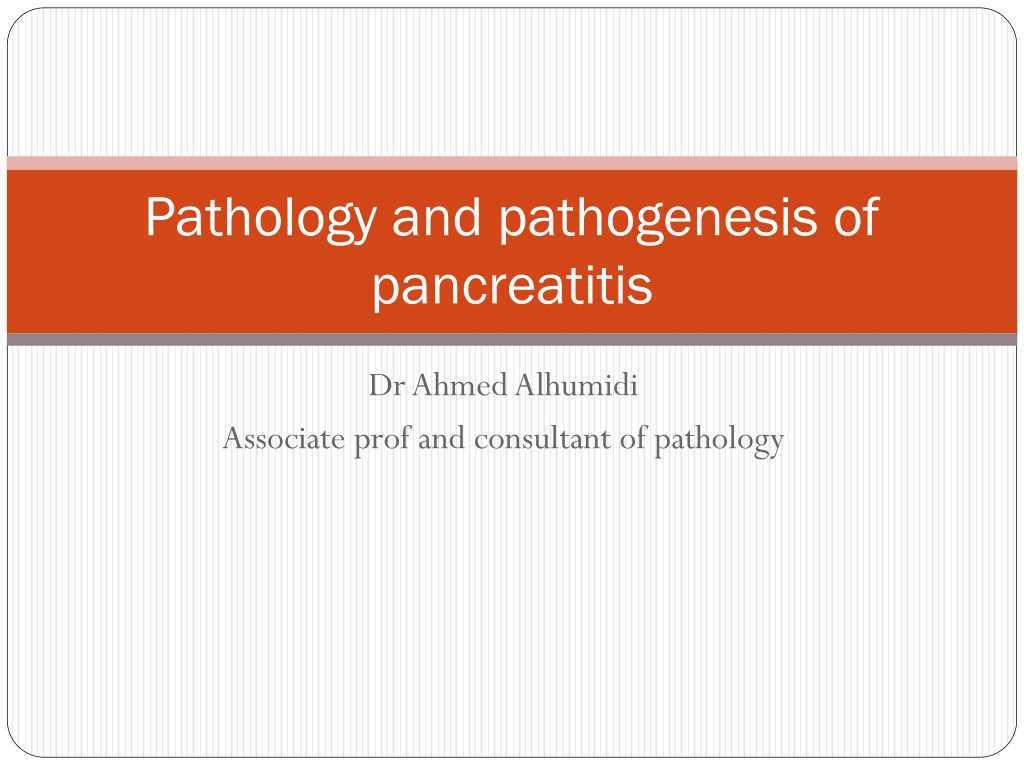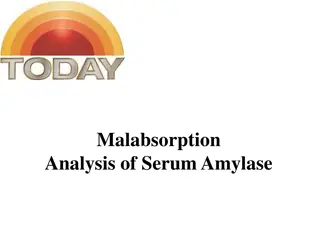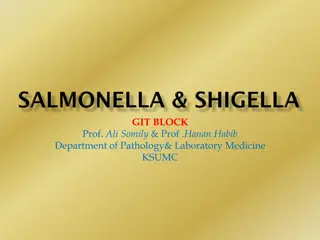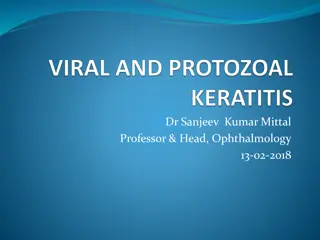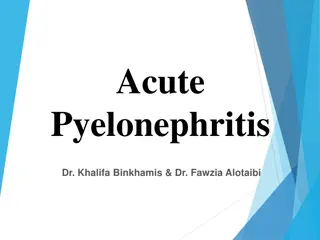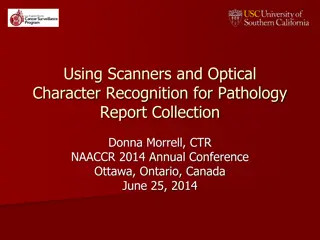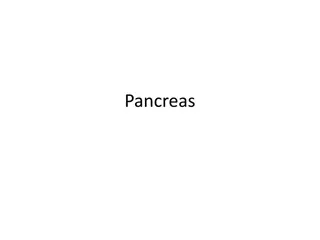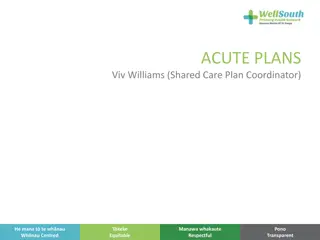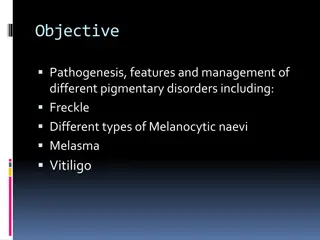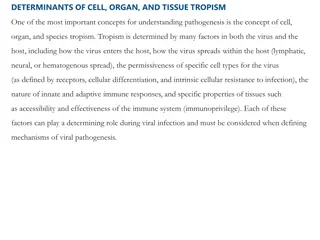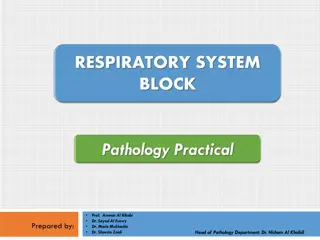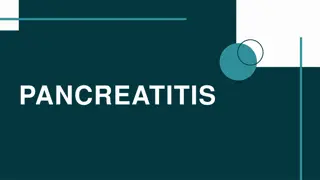Understanding Acute Pancreatitis: Pathology, Pathogenesis, and Clinical Features
This educational material delves into the pathology, pathogenesis, and clinical features of acute pancreatitis, detailing the causes, morphological changes, and diagnostic challenges associated with this medical condition. Detailed explanations and images help enhance understanding for medical professionals and students alike.
Download Presentation

Please find below an Image/Link to download the presentation.
The content on the website is provided AS IS for your information and personal use only. It may not be sold, licensed, or shared on other websites without obtaining consent from the author. Download presentation by click this link. If you encounter any issues during the download, it is possible that the publisher has removed the file from their server.
E N D
Presentation Transcript
Pathology and pathogenesis of pancreatitis DrAhmed Alhumidi Associate prof and consultant of pathology
Objectives Describe the pathology of acute and chronic pancreatitis Understand the pathogenesis of acute and chronic pancreatitis Describe the clinical features and possible complications of acute and chronic panreatitis.
The pancreas is in reality two organs in one. 1. 90% .exocrine (digestion of food). 2. 10% endocrine (hormones). Pancreatitis is inflammation of the pancreas.
Acute Pancreatitis mild self-limited life threatening process Return to normal if underlying cause is removed. biliary tract disease Gallstones common causes 80% alcoholism Obstruction of the pancreatic duct system Less common causes 85 drugs Medications sulfonamides Metabolic disorders Acute ischemia Trauma
Pathogenesis The pancreas is normally protected from autodigestion by synthesis of pancreatic enzymes in the acinar cell in the proenzyme form Pathogenesis.autodigestion of the pancreatic substance by inappropriately activated pancreatic enzymes. Thus, activation of trypsinogen is an important triggering event in acute pancreatitis.
Acute pancreatitis: Morphology Severe Mild Microvascular leakage Edema Lipase Fat necrosis Protease Destruction of pancreatic parenchyma Elastase hemorrhage Fat necrosis results from enzymatic destruction of fat cells; the released fatty acids combine with calcium to form insoluble salts that precipitate in situ.
Acute pancreatitis: Clinical Features. Abdominal pain is the cardinal manifestation of acute pancreatitis. Its severity varies from mild to severe. Full-blown acute pancreatitis is a medical emergency of the first magnitude. These patients usually have the sudden onset of an "acute abdomen" that must be differentiated from diseases such as ruptured acute appendicitis, perforated peptic ulcer, acute cholecystitis with rupture, and occlusion of mesenteric vessels with infarction of the bowel.
Acute pancreatitis: Clinical Features. Often referred to the upper back leukocytosis, hemolysis, disseminated intravascular coagulation, acute respiratory distress syndrome shock with acute renal tubular necrosis may occur
Acute pancreatitis Laboratory findings: marked elevation of serum amylase levels during the first 24 hours, followed within 72 to 96 hours by a rising serum lipase level.
Case study A 42-year-old obese woman presents with severe abdominal pain that radiates to the back. The blood pressure is 90/45 mm Hg, Physical examination shows abdominal tenderness, guarding, and rigidity. An X-ray film of the chest shows a left pleural effusion. Laboratory studies reveal elevated serum amylase (850 U/L) and lipase (675 U/L), and hypocalcemia (7.8 mg/dL). Acute pancreatitis
Acute pancreatitis treatment and prognosis The key to the management is "resting" the pancreas by total restriction of food and fluids and by supportive therapy. Most patients recover fully. About 5% die from shock during the first week of illness. Acute respiratory distress syndrome and acute renal failure are fatal complications. In surviving patients, sequelae include a sterile pancreatic abscess and a pancreatic pseudocyst.
Chronic pancreatitis Chronic pancreatitis is characterized by inflammation of the pancreas with destruction of exocrine parenchyma, fibrosis, and, in the late stages, the destruction of endocrine parenchyma. The chief distinction between acute and chronic pancreatitis is the irreversible impairment in pancreatic function that is characteristic of chronic pancreatitis.
Chronic pancreatitis There is significant overlap in the causes of acute and chronic pancreatitis. By far the most common cause of chronic pancreatitis is long-term alcohol abuse and biliary tract disease, and these patients are usually middle-aged males.
Chronic pancreatitis Less common causes of chronic pancreatitis include the following: Hypercalcemia, hyperlipidemia. Long-standing obstruction of the pancreatic duct by pseudocysts, calculi, trauma,or neoplasm. Tropical pancreatitis, which is a poorly characterized disease seen in Africa and Asia. It has been attributed to malnutrition. Hereditary pancreatitis (PRSS1 mutations ) Idiopathic chronic pancreatitis.
parenchymal fibrosis relative sparing of the islets of Langerhans, Ducts dilatation Acinar atrophy
Chronic pancreatitis: Clinical Features Silent or repeated attacks of abdominal pain, or persistent abdominal and back pain. Attacks may be precipitated by alcohol abuse, overeating (which increases demand on the pancreas), or the use of opiates and other drugs.
Chronic pancreatitis: Clinical Features During an attack of abdominal pain, there may be mild fever and mild-to-moderate elevations of serum amylase. Calcifications can be seen abdominal x ray. Complications: Severe pancreatic exocrine insufficiency, chronic malabsorption, diabetes mellitus (due to destruction of islets of Langerhans),and pancreatic pseudocysts.
PSEUDOCYSTS OF PANCREAS Pseudocysts are localized collections of necrotic-hemorrhagic material rich in pancreatic enzymes. Such cysts lack an epithelial lining (hence the prefix "pseudo"), and they account for majority of cysts in the pancreas. Pseudocysts usually arise after an episode of acute pancreatitis, or of chronic alcoholic pancreatitis.
PSEUDOCYSTS OF PANCREAS Morphology. Pseudocysts are usually solitary. Pseudocysts can range in size from 2 to 30 cm in diameter. While many pseudocysts spontaneously resolve, they may become secondarily infected, and larger pseudocysts may compress or even perforate into adjacent structures.
Objectives Describe the pathology of acute and chronic pancreatitis Understand the pathogenesis of acute and chronic pancreatitis Describe the clinical features and possible complications of acute and chronic panreatitis.
chronic chronic pancreatitis pancreatitis Gallstone alcohol others Acute pancreatitis Acute pancreatitis Gallstone alcohol others, Acute abdomen Chronic Abdominal pain Activation of trypsinogen Activation of trypsinogen fibrotic destruction Fat necrosis, hemorrhage Fibrosis, Acinar atrophy serum amylase mild serum amylase irreversible impairment in pancreatic function, chronic malabsorption, diabetes mellitus Shock pancreatic abscess Pleural effusion pseudocysts pseudocysts
A 60-year-old alcoholic man presents with a 6-month history of recurrent epigastric pain, progressive weight loss, and foul smelling diarrhea. The abdominal pain is now almost constant and intractable. An X-ray film of the abdomen reveals multiple areas of calcification in the mid-abdomen. Which of the following is the most likely diagnosis? (A) Carcinoid syndrome (B) Chronic pancreatitis (C) Crohn disease (D) Insulinoma (E) Miliary tuberculosis
The answer is B: Chronic pancreatitis. Chronic pancreatitis is characterized by the progressive destruction of the pancreas, with accompanying irregular fibrosis and chronic inflammation. Calcification and intraductal calculi often develop. Pancreatic insufficiency results in malabsorption syndrome. Chronic pancreatitis is most commonly seen in patients with a history of alcohol abuse (70% of cases). The other choices are not associated with pancreatic calcifications. Although islets may be affected by chronic pancreatitis, hypoglycemia is an uncommon and late feature of the disease. Diagnosis: Pancreatitis, chronic
Which of the following findings is most likely to be encountered in the patient described in previous Question ? (A) Achlorhydria (B) Hypoglycemia (C) Melena (D) Pernicious anemia (E) Steatorrhea
The answer is E: Steatorrhea. Fat malabsorption in the setting of chronic pancreatitis is most often associated with steatorrhea. In patients with steatorrhea, the fecal matter is foul smelling and fl oats because of a high fat content. Longstanding malabsorptive disease is accompanied by nutritional defi ciency, including weight loss, anemia osteomalacia, and a tendency to bleed. Hypoglycemia (choice B) is incorrect because loss of pancreatic islet cells would be associated with hyperglycemia. Diagnosis: Pancreatitis, chronic; steatorrhea
A 50-year-old woman complains of persistent abdominal pain, anorexia, and abdominal distention. Her past medical history is significant for a previous hospitalization for acute pancreatitis. A CT scan of the abdomen shows a fluid-filled cavity in the head of the pancreas. What is the most likely diagnosis? (A) Acute hemorrhagic pancreatitis (B) Insulinoma (C) Pancreatic cystadenoma (D) Pancreatic islet cell tumor (E) Pancreatic pseudocyst
The answer is E: Pancreatic pseudocyst. Pancreatic pseudocyst is a late complication of acute pancreatitis, in which necrotic pancreatic tissue is liquefi ed through the action of pancreatic enzymes (e.g., peptidases, lipases, and amylase). The necrotic tissue becomes encapsulated by granulation tissue, which then develops into a fibrous capsule. Pseudocysts may enlarge to compress and even obstruct theduodenum. They may become secondarily infected and form an abscess. Choices B, C, and D are not consequences of acute pancreatitis. Diagnosis: Pancreatic pseudocyst
